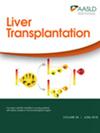长时间低体温氧合灌注有好处吗?- 一项全国性回顾性研究的结果。
IF 4.7
2区 医学
Q1 GASTROENTEROLOGY & HEPATOLOGY
引用次数: 0
摘要
背景双低温氧合灌注(DHOPE)越来越多地被用于延长肝脏保存时间,以改善移植物流。然而,人们对其在高风险肝移植中的益处知之甚少。本研究旨在调查延长 DHOPE 是否能为所有类型的肝脏提供除改善物流之外的其他益处。方法我们对 2015 年至 2022 年期间来自 12 个意大利中心的 177 例肝移植进行了全国性回顾性队列研究,这些肝移植均采用 DHOPE 保存≥4 小时。我们使用 1:1 倾向评分匹配法创建了一个对照组,该对照组包括同期内 177 例 DHOPE <4h 的患者。使用单变量和多变量回归模型评估了风险概况和保存时间对预后的影响。结果 未发现长时间和短时间 DHOPE 在移植后预后方面存在显著差异。然而,与短时间组相比,长时间组移植后急性肾损伤(AKI)的发生率明显较低(30.5% 对 44.6%,P=0.008)。在DHOPE持续时间较长的患者中,根据供体风险指数(DRI)、欧洲移植对边缘移植物的定义以及风险平衡(BAR)评分,没有观察到移植结果的差异。在根据 DRI、欧洲移植边缘移植物和 BAR 评分调整的多变量模型中,DHOPE 持续时间与较低的 AKI 风险相关。结论延长 DHOPE 被广泛用于改善移植物流,对高风险移植物具有良好效果,并且似乎与较低的移植后 AKI 风险相关。这些结果进一步说明了 DHOPE 在预防移植后并发症方面的重要作用。本文章由计算机程序翻译,如有差异,请以英文原文为准。
Are there any benefits of prolonged hypothermic oxygenated perfusion? - Results from a national retrospective study.
BACKGROUND
Dual hypothermic oxygenated perfusion (DHOPE) is increasingly being used to extend liver preservation to improve transplant logistics. However, little is known about its benefits in high-risk liver grafts. This study aimed to investigate whether prolonged DHOPE provides benefits other than improved logistics in all liver types.
METHODS
We performed a national retrospective cohort study of 177 liver transplants from 12 Italian centers preserved with DHOPE for ≥4h between 2015 and 2022. A control group of 177 DHOPEs of <4h during the same period was created using 1:1 propensity score matching. The impact of risk profiles and preservation times on the outcomes was assessed using univariable and multivariable regression models.
RESULTS
No significant differences in post-transplant outcomes were found between prolonged and short DHOPEs. However, the prolonged group had a significantly lower incidence of post-transplant acute kidney injury (AKI) compared to the short group (30.5% vs. 44.6%, p=0.008). Among prolonged DHOPEs, no differences in transplant outcomes were observed according to donor risk index (DRI), Eurotransplant definition for marginal grafts, and balance of risk (BAR) score. DHOPE duration was associated with a lower risk of AKI in multivariable models adjusted for DRI, Eutrotransplant marginal grafts, and BAR score. Prolonged HOPE confirmed its protective effect against AKI in a multivariable model adjusted for donor and recipient risk factors [OR: 0.412, 95%CI: 0.200-0.850, p=0.016].
CONCLUSIONS
Prolonged DHOPE is widely used to improve transplant logistics, provides good results with high-risk grafts, and appears to be associated with a lower risk of post-transplant AKI. These results provide further insight into the important role of DHOPE in preventing post-transplant complications.
求助全文
通过发布文献求助,成功后即可免费获取论文全文。
去求助
来源期刊

Liver Transplantation
医学-外科
CiteScore
7.40
自引率
6.50%
发文量
254
审稿时长
3-8 weeks
期刊介绍:
Since the first application of liver transplantation in a clinical situation was reported more than twenty years ago, there has been a great deal of growth in this field and more is anticipated. As an official publication of the AASLD, Liver Transplantation delivers current, peer-reviewed articles on liver transplantation, liver surgery, and chronic liver disease — the information necessary to keep abreast of this evolving specialty.
 求助内容:
求助内容: 应助结果提醒方式:
应助结果提醒方式:


